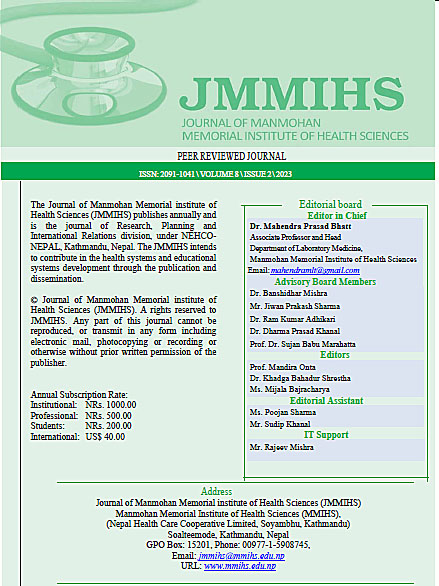Effect Of Breastfeeding Among Under 2 Years Children In Kaski District, Nepal
DOI:
https://doi.org/10.3126/jmmihs.v8i2.59756Keywords:
Breastfeeding, Under 2 years, Children, NepalAbstract
Background: Breastfeeding is one of the most important determinants of child survival, birth spacing, and the prevention of childhood infections. The beneficial effects of breastfeeding depend on its initiation, duration, and the age at which the breastfed child is weaned. Breastfeeding positively influences cognitive development.
Methods: A descriptive cross-sectional study design was used to study impacts of breastfeeding among under 2 year’s children in Kaski district. Interview schedule as a structured questionnaire was used as data collection tool. Data was entered in Epi-data and analysis was performed with the help of the Statistical Package for Social Science.
Results: The result showed nearly one-third (30.9%) of the respondents had fed bottle milk to their children. Majority (85.7%) of respondents had knowledge about effect of breastfeeding. Majority (78.9%) of the children were stunted and 27.8% of children are underweight. Very few (5.3%) of children were found wasted. Sex (p 0.044), suffering from disease (p 0.046), duration of breastfeeding (p 0.001), breastfeeding interval (p 0.001), breastfeeding time in day (p 0.001) were statistically associated with effect of breastfeeding. Height and weight, age and weight was found positively correlated (p<0.05).
Conclusion: The study showed child who were breastfed frequently were normal in weight; their physical development is found good. There is positive co-relation between height and weight as well as age and weight. BCC programme should be conducted for breastfeeding mothers on time, interval, duration of breastfeeding
Downloads
Downloads
Published
How to Cite
Issue
Section
License
© Journal of Manmohan Memorial Institute of Health Sciences (JMMIHS)
All rights reserved to JMMIHS. Any part of this journal cannot be reproduced, or transmitted in any form including electronic mail, photocopying or recording or otherwise without prior written permission of the publisher.


